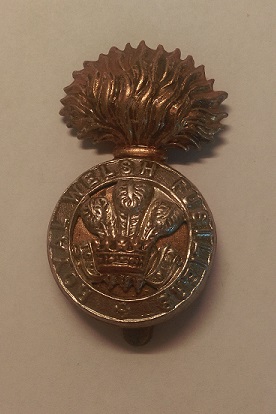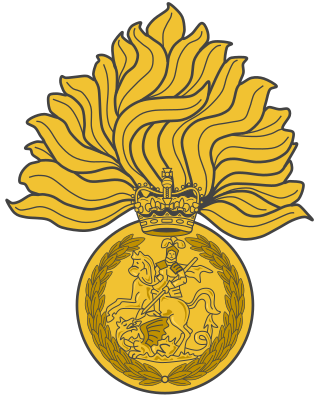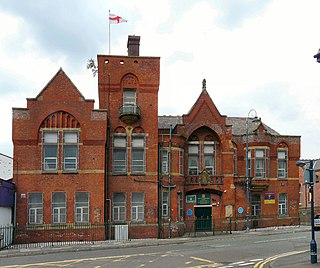
The Royal Welch Fusiliers (Welsh: Ffiwsilwyr Brenhinol Cymreig) was a line infantry regiment of the British Army, and part of the Prince of Wales's Division, that was founded in 1689; shortly after the Glorious Revolution. In 1702, it was designated a fusilier regiment and became the Welch Regiment of Fusiliers; the prefix "Royal" was added in 1713, then confirmed in 1714 when George I named it the Prince of Wales's Own Royal Regiment of Welsh Fusiliers. In 1751, after reforms that standardised the naming and numbering of regiments, it became the 23rd Regiment of Foot (Royal Welsh Fuzileers). In 1881, the final title of the regiment was adopted.

The 42nd Infantry Division was an infantry division of the British Army. The division was raised in 1908 as part of the Territorial Force (TF), originally as the East Lancashire Division, and was redesignated as the 42nd Division on 25 May 1915. It was the first TF division to be sent overseas during the First World War. The division fought at Gallipoli, in the Sinai desert and on the Western Front in France and Belgium. Disbanded after the war, it was reformed in the Territorial Army (TA), in the Second World War it served as the 42nd Infantry Division with the British Expeditionary Force (BEF) and fought in Belgium and France before being evacuated at Dunkirk. The division was later reformed in the United Kingdom and, in November 1941, was converted into the 42nd Armoured Division, which was disbanded in October 1943 without serving overseas. A 2nd Line duplicate formation, the 66th Infantry Division, was created when the Territorials were doubled in both world wars.

The Royal Regiment of Fusiliers is an infantry regiment of the British Army, part of the Queen's Division. Currently, the regiment has two battalions: the 1st Battalion, part of the Regular Army, is an armoured infantry battalion based in Tidworth, Wiltshire, and the 5th Battalion, part of the Army Reserve, recruits in the traditional fusilier recruiting areas across England. The Royal Regiment of Fusiliers was largely unaffected by the infantry reforms that were announced in December 2004, but under the Army 2020 reduction in the size of the Army, the 2nd Battalion was merged into the first in 2014.

The Lancashire Fusiliers was a line infantry regiment of the British Army that saw distinguished service through many years and wars, including the Second Boer War, the First and Second World Wars, and had many different titles throughout its 280 years of existence. In 1968 the regiment was amalgamated with the other regiments of the Fusilier Brigade – the Royal Northumberland Fusiliers, Royal Warwickshire Fusiliers and the Royal Fusiliers – to form the current Royal Regiment of Fusiliers.

The Royal Warwickshire Regiment, previously titled the 6th Regiment of Foot, was a line infantry regiment of the British Army in continuous existence for 283 years. The regiment saw service in many conflicts and wars, including the Second Boer War and both the First and Second World Wars. On 1 May 1963, the regiment was re-titled, for the final time, as the Royal Warwickshire Fusiliers and became part of the Fusilier Brigade.

The 52nd Lowland Volunteers is a battalion in the British Army's Army Reserve or reserve force in the Scottish Lowlands, forming the 6th Battalion of the Royal Regiment of Scotland, also known as 6 SCOTS. Due to its erstwhile association with the 1st Regiment of Foot, it is the senior Reserve line infantry battalion in the British Army. It is one of two Reserve battalions in the Royal Regiment of Scotland, along with 51st Highland, a similar unit located in the Scottish Highlands.

The 125th Brigade was an infantry brigade formation of the British Army that saw active service during both the First and Second World Wars. It was assigned to the 42nd Division and served in the Middle East and later in the trenches of the Western Front in the First World War. In the Second World War the brigade, now redesignated 125th Infantry Brigade, fought in Belgium and France before being evacuated at Dunkirk and was then converted into 10th Armoured Brigade.
The Liverpool Brigade, later 165th (Liverpool) Brigade was an infantry brigade of Britain's Volunteer Force that served during World War I with the 55th Division of the British Army. During World War II, again as part of the 55th Infantry Division, the brigade remained in the United Kingdom.
The 166th Brigade was an infantry brigade of the British Army that saw active service in the First World War and remained in the United Kingdom throughout the Second World War.

The Castle Armoury is a former military installation in Bury, Greater Manchester, England.

The Army Riding School was a military installation in Northumberland Road, Newcastle upon Tyne.

The Phoenix Street drill hall is a former military installation in Lancaster, Lancashire.

Dare Wilson Barracks, is a military installation in Hexham, Northumberland. The building is named after Major General Dare Wilson who was commissioned into the Royal Northumberland Fusiliers and commanded 22 Special Air Service Regiment in the early 1960s.

The Fenkle Street drill hall is a former military installation in Alnwick, Northumberland. It is a Grade II* listed building and is now used by the Northumberland County Council.

The Poyser Street drill hall is a former military installation in Wrexham, Wales.

The Bank Parade drill hall, also known as the Keighley Green Drill Hall, is a former military installation in Burnley, Lancashire.

The Bath Street drill hall is a former military installation in Warrington, Cheshire.

The Old Street drill hall is a former military installation in Ashton-under-Lyne, Greater Manchester, England.
The 1st Manchester Rifles, later the 6th Battalion, Manchester Regiment, was a unit of Britain's Volunteer Force and Territorial Army recruited in and around Manchester. It served as infantry at Gallipoli, fighting with distinction at the Third Battle of Krithia, and in some of the bitterest battles on the Western Front in the First World War. After conversion into an anti-aircraft unit of the Royal Artillery between the wars, it defended Manchester, Scapa Flow and Ceylon during the Second World War and continued in the air defence role until 1955.

The 2nd Northumberland Rifle Volunteer Corps, also referred to as the Tynemouth Rifles, was an infantry unit of Britain's part-time force, the Territorial Army. The corps was raised during the expansion of the Volunteer movement in the 1850s and then served with the Territorial Force during the First World War. It converted to an anti-aircraft role just prior to Second World War, and continued to serve until it was amalgamated in 1950.





















